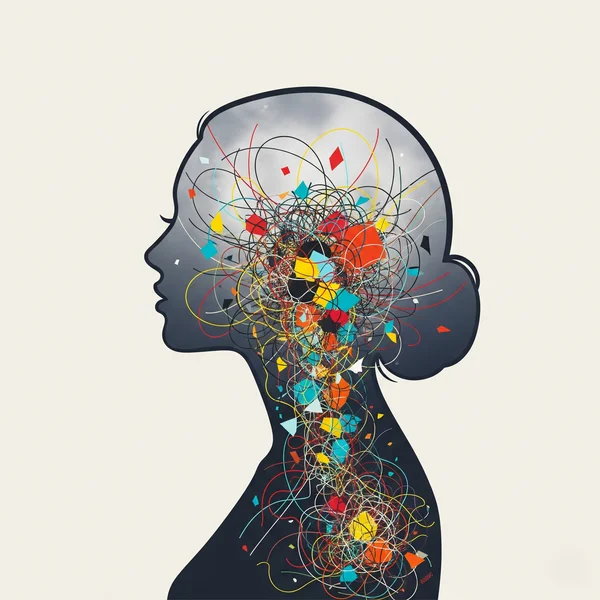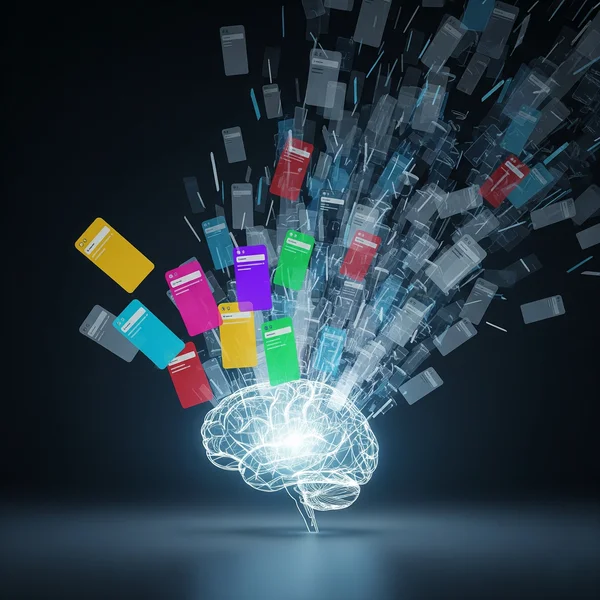ADHD dalam Kalangan Wanita: Panduan Simptom Tersembunyi
Merasa terbeban, sentiasa mempunyai 'motor' dalaman yang berjalan, namun diberitahu anda hanya "terlalu sensitif" atau "gelisah"? Anda tidak bersendirian. Bagi wanita yang tidak terkira, gambaran tipikal ADHD—seorang budak lelaki yang melompat-lompat—tidak sepadan dengan realiti mereka. Ini menyebabkan mereka bergelut dalam diam selama bertahun-tahun. Bagaimana rupa ADHD pada wanita? Ia sering kelihatan seperti perjuangan yang berterusan dan senyap dengan minda anda sendiri. Jika ini kedengaran seperti anda, langkah pertama untuk memahami ialah pengetahuan, dan permulaan yang baik ialah kuiz ADHD untuk wanita yang boleh dipercayai.
Mengapa Simptom ADHD Wanita Selalu Terlepas Pandang
Selama beberapa dekad, penyelidikan dan kriteria diagnostik untuk ADHD hampir secara eksklusif berdasarkan kajian terhadap kanak-kanak lelaki yang hiperaktif. Ini telah mewujudkan jurang yang ketara dalam pemahaman dan pengenalan keadaan ini pada kanak-kanak perempuan dan wanita. Sebab-sebab simptom anda mungkin terlepas pandang adalah kompleks dan berakar umbi dalam sains dan jangkaan masyarakat.
Stereotaip "Budak Lelaki Hiperaktif"
Apabila kebanyakan orang memikirkan ADHD, mereka membayangkan hiperaktif luaran. Walau bagaimanapun, wanita dengan ADHD lebih cenderung menunjukkan jenis yang tidak fokus. Ini bukanlah kekurangan hiperaktif, tetapi lebih kepada hiperaktif yang ke dalam—menjelma sebagai pemikiran yang pantas, rasa gelisah yang berterusan, atau "bualan minda" yang nampaknya tidak pernah berhenti. Kerana gangguan yang lebih sedikit kepada orang lain, ia mudah dianggap sebagai melamun atau berada "dalam dunia sendiri."
Tekanan Topeng Sosial dan "Menyesuaikan Diri"
Sejak kecil, kanak-kanak perempuan sering disosialisasikan untuk patuh, bersetuju, dan teratur. Tekanan yang besar ini mendorong ramai untuk membangunkan mekanisme menangani yang canggih, satu amalan yang dikenali sebagai menyamarkan ADHD. Anda mungkin meletihkan diri sendiri cuba kelihatan "normal" dengan merancang secara teliti, bersedia lebih awal untuk situasi sosial, dan meniru tingkah laku rakan sebaya anda. Walaupun ini membantu anda berfungsi, ia datang dengan kos yang sangat besar kepada tenaga mental dan rasa diri anda, menjadikan disfungsi eksekutif yang mendasarinya tidak kelihatan kepada orang luar.
Bertindih dengan Kebimbangan dan Kemurungan
Hidup dengan ADHD yang tidak didiagnosis adalah tekanan dan boleh menjejaskan harga diri secara teruk. Perjuangan berterusan untuk terus maju, perasaan kegagalan, dan pergolakan emosi sering salah didiagnosis sebagai kebimbangan atau kemurungan utama. Walaupun kebimbangan dan ADHD boleh wujud bersama, merawat hanya kebimbangan tanpa menangani punca utama—ADHD—adalah seperti membuang air dari bot tanpa membetulkan kebocoran. Ramai wanita menghabiskan bertahun-tahun dengan ubat anti-kebimbangan atau antidepresan dengan sedikit kelegaan, kerana isu teras tetap tidak ditangani.

Tanda-tanda Utama ADHD pada Wanita Dewasa yang Tidak Harus Anda Abaikan
Mengenali ADHD pada diri sendiri memerlukan melihat melangkaui permukaan. Simptom ADHD pada wanita dewasa seringkali halus, bernuansa, dan saling berkait rapat dengan dunia emosi dan dalaman anda. Berikut adalah beberapa petunjuk utama bahawa perjuangan anda mungkin lebih daripada sekadar kekurangan watak.
Melangkaui Ketidakfokusan: "Bualan Minda" yang Berterusan
Ini bukan hanya tentang kehilangan kunci anda. Bagi ramai wanita dengan ADHD, ketidakfokusan terasa seperti mempunyai pelayar dengan 100 tab terbuka di otak anda, semuanya memainkan bunyi yang berbeza serentak. Bualan minda ini menjadikannya sangat sukar untuk menumpukan perhatian pada satu tugas, mengikuti perbualan, atau bahkan berehat. Anda mungkin mendapati diri anda memulakan pelbagai projek tetapi tidak menyelesaikan satu pun, atau berasa letih secara mental hanya kerana cuba berfikir dengan jelas.
Disregulasi Emosi dan Kepekaan Penolakan (RSD)
Adakah kritikan kecil terasa malapetaka? Adakah anda mengalami perubahan emosi yang kuat dan luar biasa yang nampaknya datang dari tiada tempat? Ini adalah ciri khas disregulasi emosi dalam ADHD. Ia sering disertai dengan Disforia Kepekaan Penolakan (RSD), kepekaan emosi dan kesakitan yang melampau yang dicetuskan oleh persepsi ditolak, diejek, atau dikritik. Ia bukanlah "dramatik"—ia adalah respons neurologi yang sangat nyata dan menyakitkan.

Perjuangan Tersembunyi dengan Fungsi Eksekutif
Fungsi eksekutif ialah kemahiran pengurusan otak. Bagi wanita dengan ADHD, ini adalah kawasan utama kesukaran. Ia boleh menjelma sebagai:
- Penangguhan kronik, terutamanya pada tugasan yang kelihatan membosankan atau membebankan.
- Kesukaran pengurusan masa, sering lewat atau meremehkan masa yang diambil untuk tugasan.
- Rumah atau ruang kerja yang terasa sentiasa tidak teratur dan bersepah, walaupun usaha terbaik anda.
- Kesukaran merancang dan mengutamakan, daripada senarai barangan runcit hingga matlamat hidup jangka panjang.
Hiperfokus: Sisi "Kuasa Super" ADHD
ADHD bukan hanya tentang defisit. Ramai wanita juga mengalami hiperfokus—keadaan tumpuan yang sengit dan berpanjangan pada subjek yang mereka dapati menarik. Semasa hiperfokus, dunia luar boleh lenyap. Walaupun ia boleh menjadi aset yang kuat, membolehkan anda menyelesaikan perkara yang luar biasa dalam masa yang singkat, ia juga boleh menjadi cabaran, menyebabkan anda mengabaikan tanggungjawab penting lain. Jika anda tertanya-tanya tentang corak anda sendiri, mengambil kuiz ADHD dewasa secara sulit boleh memberikan pandangan yang berharga.
Sambungan Hormon: Estrogen, Progesteron, dan ADHD
Aspek penting ADHD pada wanita yang sering terlepas pandang ialah interaksinya dengan perubahan hormon. Neurotransmitter yang terjejas oleh ADHD, seperti dopamin, juga dipengaruhi oleh hormon seperti estrogen.
Bagaimana Kitaran Haid Anda Boleh Mempengaruhi Simptom ADHD Anda
Ramai wanita melaporkan bahawa simptom ADHD mereka bertambah teruk secara signifikan pada minggu atau dua minggu sebelum haid mereka, apabila tahap estrogen menurun. Anda mungkin mendapati tumpuan anda lebih teruk, emosi anda lebih sukar diurus, dan ubat anda (jika anda mengambilnya) nampaknya kurang berkesan. Melakar simptom anda bersama-sama dengan kitaran anda boleh menjadi pengalaman yang membuka mata.
ADHD Semasa Perimenopaus dan Menopaus
Perubahan hormon yang ketara semasa perimenopaus dan menopaus boleh mendedahkan atau memperburuk simptom ADHD secara dramatik. Penurunan estrogen boleh terasa seperti "pengurus" otak anda telah bercuti kekal, membawa kepada peningkatan mendadak dalam kesukaran fokus dan ingatan, masalah ingatan, dan ketidakstabilan emosi. Bagi sesetengah orang, ini adalah kali pertama dalam hidup mereka mereka mencari diagnosis ADHD.
Apa Seterusnya? Cara Mencari Kejelasan dan Sokongan

Menyedari bahawa perjuangan sepanjang hayat anda mungkin mempunyai nama adalah detik yang berkuasa, dan kadang-kadang membebankan. Perjalanan menuju kejelasan adalah maraton, bukan larian pecut, tetapi anda boleh mengambil langkah pertama hari ini.
Langkah Pertama: Ambil Kuiz ADHD Kami untuk Wanita
Tertanya-tanya, "Adakah saya menghidapi ADHD? (Kuiz untuk wanita)" Kuiz kami adalah tempat yang sesuai untuk bermula. Ia direka berdasarkan alat klinikal yang mantap seperti Skala Laporan Kendiri ADHD Dewasa (ASRS) WHO untuk membantu anda menyaring cara khusus ADHD muncul pada wanita. Ia sulit, mengambil masa hanya beberapa minit, dan memberikan laporan terperinci segera yang boleh anda gunakan untuk refleksi diri. Ambil langkah pertama ke arah kejelasan sekarang.
Cara Bersedia untuk Perbualan dengan Doktor Anda
Kuiz dalam talian bukanlah diagnosis, tetapi ia adalah alat yang berkuasa. Selepas melengkapkan kuiz, anda boleh:
- Cetak atau simpan keputusan anda. Ini memberi anda ringkasan pengalaman anda yang konkrit dan terstruktur.
- Buat senarai contoh spesifik daripada kehidupan anda yang berkaitan dengan soalan kuiz.
- Bawa maklumat ini kepada profesional penjagaan kesihatan yang berkelayakan. Ia akan membantu anda mempunyai perbualan yang lebih produktif dan memperjuangkan diri anda dengan berkesan.
Anda Tidak Bersendirian: Merangkul Neurotaip Anda
Memahami bahawa anda mungkin mempunyai ADHD bukanlah tentang mencari alasan; ia tentang mencari penjelasan. Ia adalah kunci yang boleh membuka berdekad-dekad menyalahkan diri sendiri dan kekeliruan. Anda tidak malas, rosak, atau "terlalu banyak." Otak anda sememangnya berwayar berbeza. Merangkul ini boleh menjadi permulaan hubungan baru yang lebih penyayang dengan diri anda.
Soalan Anda Tentang ADHD pada Wanita Dijawab
Bolehkah anda menghidapi ADHD sebagai wanita dewasa?
Secara teknikalnya, tidak. ADHD adalah keadaan neurodevelopmental, yang bermaksud ia berasal dari zaman kanak-kanak. Walau bagaimanapun, sangat biasa wanita tidak didiagnosis sehingga dewasa, apabila tuntutan kehidupan (kerjaya, keluarga, dll.) mengatasi mekanisme menangani mereka. Jadi, walaupun anda tidak "menghidapi"nya sebagai orang dewasa, anda pastinya boleh "menemuinya."
Apakah perbezaan utama antara ADHD pada lelaki dan wanita?
Perbezaan terbesar adalah dalam persembahannya. Lelaki lebih cenderung menunjukkan simptom hiperaktif-impulsif yang dieksternalisasi. Wanita cenderung mempunyai simptom tidak fokus yang lebih dalaman, bersama-sama dengan cabaran yang lebih ketara dengan disregulasi emosi dan kadar kebimbangan dan kemurungan yang berlaku lebih tinggi.
Bolehkah kuiz ADHD ini benar-benar membantu mengenal pasti simptom wanita?
Ya. Walaupun bukan alat diagnostik, kuiz yang direka dengan baik boleh sangat membantu. Kuiz ADHD percuma kami distrukturkan untuk menangkap pelbagai simptom, termasuk yang halus, dalaman yang sering dialami oleh wanita, memberikan anda gambaran yang lebih jelas sama ada pengalaman anda sejajar dengan kriteria untuk ADHD.